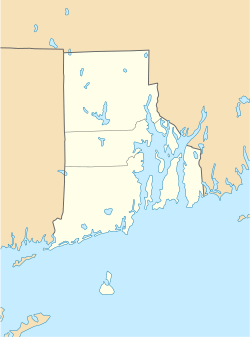Greenwich Cove Site facts for kids
Quick facts for kids |
|
|
Greenwich Cove Site
|
|
| Location | Southern end of Greenwich Cove, Warwick, Rhode Island |
|---|---|
| NRHP reference No. | 80000077 |
| Added to NRHP | January 4, 1980 |
The Greenwich Cove Site is a very old place in Warwick, Rhode Island. It's an important archaeological site where scientists have found clues about people who lived there long, long ago. These clues tell us about life from the Late Archaic to the Middle Woodland Period. That's a huge span of time, from about 8,000 to 1,000 years ago!
One special part of the site is a large pile of shells. This is called a shell midden. It's like an ancient trash heap, but it holds valuable information. This shell midden is quite rare in Rhode Island, especially one that hasn't been too damaged. In 1980, the Greenwich Cove Site was added to the National Register of Historic Places. This means it's recognized as a very important historical place.
Contents
Discovering the Greenwich Cove Site
The Greenwich Cove Site was found by accident in 1976. Workers were building new homes in a neighborhood when they uncovered ancient artifacts. This discovery led archaeologists to investigate the area.
Scientists dug small test holes to see what was there. They found a shell midden and an area where people used to live. This living area was on a small hill overlooking Narragansett Bay. The only source of fresh water nearby was a kettlehole, which is a small pond formed by melting glaciers.
Saving the Site
In 1979, the site was in danger of being completely destroyed by more building work. To save the valuable history, archaeologists quickly carried out a large "salvage excavation." This means they dug up as much as they could before the land was changed forever.
During this dig, they found many interesting things. These included:
- A small number of stone tools, like arrowheads (called projectile points) and scrapers.
- Lots of small stone chips. These chips are evidence that people were making stone tools right there.
Exploring the Shell Midden
Archaeologists dug into the shell midden, which was about 14 by 16 meters (46 by 52 feet) in size. Inside the midden, they found pieces of pottery. These pottery pieces had "temper" mixed in, which is material added to clay to make it stronger. They also found more stone toolmaking chips and a few pieces of animal bone.
Another nearby test hole showed signs of fire-hardened stone. This suggests people used fire for cooking or other activities. At the very bottom of this hole, they found evidence of a hearth, which is an ancient fireplace. Next to the hearth, they discovered tools made from bone and more stone pieces ready for toolmaking.
A Child's Burial
During the excavation, archaeologists also found one human burial. It was the burial of a child, who was about seven years old. This discovery helps scientists learn more about the people who lived at the site.
Why is the Site Important?
In 1980, the Greenwich Cove Site was officially listed on the National Register of Historic Places. This was done to help protect the site. The hope was that being on this list would bring attention and money for more detailed excavations. More digging could help scientists learn even more about the ancient people who lived along Greenwich Cove thousands of years ago.



